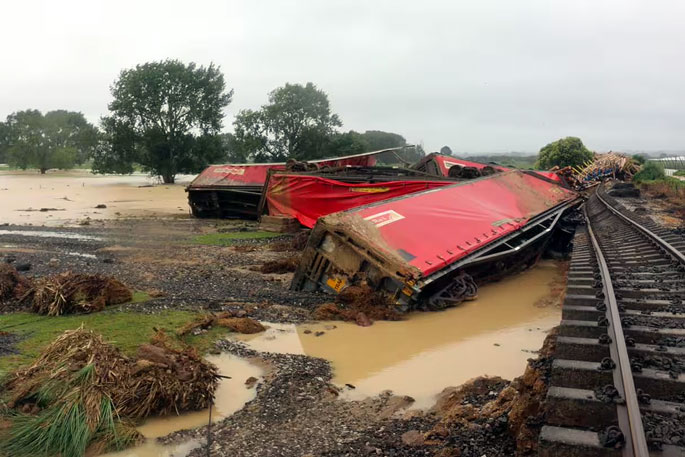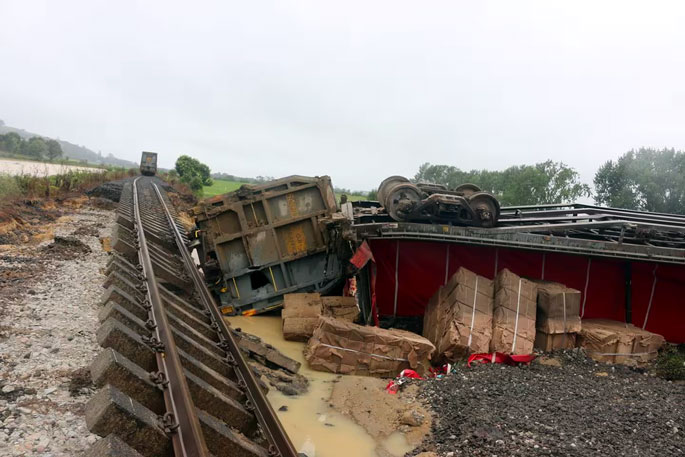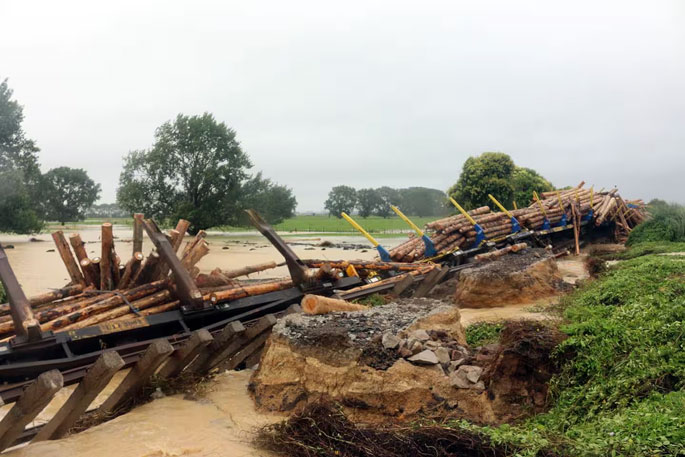A train that derailed near Te Puke during Auckland Anniversary weekend flooding last year should not have been cleared to travel on flood-hit tracks, a Transport Accident Investigation Commission report has found.
Only one of 34 wagons was still attached to the locomotive after the derailment, and the damage forced a 20-day track closure.
High water levels had been reported at the track the day before the incident but a “misunderstanding” meant the wrong section was inspected and trains were cleared to resume normal operations, the report released today said.
The commission found it was “very likely” the track inspector would have taken steps to reduce the risks had the right location been communicated.
The commission has made several recommendations to KiwiRail.
Freight in a ‘chaotic pile’ after derailment
The commission found a KiwiRail freight train was travelling from Kawerau to Tauranga on the East Coast Main Trunk line with 39 wagons in the early hours of January 29, 2023, after heavy rain and flooding. It was carrying paper pulp and logs.
The train was travelling at about 60km/h when it encountered “substantial floodwater across the track” north of Te Puke. The crew felt the locomotive drop down before the emergency brake activated automatically and the locomotive stopped.
The crew discovered only five wagons were still behind the locomotive, of which four were uncoupled.
The remaining 34 wagons about 100 metres back down the track.
Eleven wagons had derailed and lay strewn, some overturned, “with disgorged freight in a chaotic pile across fields on either side of the track”, a commission media release said.
High water reported at accident site - wrong location inspected
In the media release, chief investigator of accidents Naveen Kozhuppakalam says the accident happened because heavy rain overwhelmed the drainage system around and under the rail corridor.
At the accident site, water levels rose about 3.5 metres and washed out the stone and gravel support for the tracks.
The “fully laden” train passed over the unsupported tracks and pushed the rails out of shape. The wagon wheels lost contact with rails and the wagons derailed, he says.
“The train was cleared to travel on this section of track, but it shouldn’t have been.
“The previous day, the same train crew told Train Control that they saw high water at what became the accident site, but they did so unclearly and the track inspector inspected the wrong location.”
 A KiwiRail freight train was travelling from Kawerau to Tauranga on the East Coast Main Trunk line with 39 wagons. Photo / Tyson Smith.
A KiwiRail freight train was travelling from Kawerau to Tauranga on the East Coast Main Trunk line with 39 wagons. Photo / Tyson Smith.
To avoid similar accidents in the future, Kozhuppakalam says KiwiRail should have “triggered action response plans in place” and staff should be adequately trained to identify when and where parts of the rail corridor were vulnerable, such as this incident.
He says KiwiRail should be aware of how well third parties maintained rail corridor waterways.
“There’s more risk of flooding if third parties don’t adequately maintain their streams and culverts. So KiwiRail needs to satisfy itself that all those waterways, have effective and up-to-date maintenance programmes.”
’Greater emphasis’ on training recommended
The report says Train Control arranged a track inspection following the high water level report, but it occurred at an incorrect location due to a “misunderstanding” between the crew and Train Control.
The area inspected was about 4km south of where the crew saw high water.
The derailment caused “significant damage” to the rail wagons and cargo. There were no injuries or fatalities.
After the derailment, the track was closed for 20 days for repairs and recovery of the train’s wreckage.
 Eleven wagons derailed and lay strewn, some overturned, with disgorged freight in a chaotic pile across fields on either side of the track. Photo / Tyson Smith.
Eleven wagons derailed and lay strewn, some overturned, with disgorged freight in a chaotic pile across fields on either side of the track. Photo / Tyson Smith.
The report says the commission’s investigation found safety issues in KiwiRail’s adverse weather procedures, the “lack of emphasis” in training on reporting unusual weather conditions, and inadequate oversight of the maintenance of third-party waterways adjacent to the rail corridor.
In response to the accident, KiwiRail started a risk-based review of its severe weather event management processes, controls, and trigger action responses.
KiwiRail will introduce an organisation-wide adverse weather event standards and processes, intended to be in place by the end of the year.
The commission recommended KiwiRail review its adverse weather response system and processes to ensure they were effective in maintaining a safe rail network, which KiwiRail has accepted.
The commission also recommends KiwiRail place “greater emphasis” on training rail personnel in reporting unusual weather conditions.
KiwiRail rejected the recommendation, viewing the current training as “sufficient” for “low-level control for managing adverse weather”.
“The complexity of weather events would also preclude any meaningful training as it would otherwise require a significant number of scenarios to be credible.”
“Our adverse weather TARP [Triggered Action Response Plan] … was developed in consideration of this position and rail personnel knowledge in the way we will manage adverse weather events going forward.”
The commission also recommended KiwiRail satisfy itself that all waterways within the rail corridor, including those owned by third parties, have effective and up-to-date maintenance programmes to ensure the waterways can function as designed.
KiwiRail says the recommendation is under consideration and will require further discussion with external parties.
The report says the drainage system in the area derailment occured is owned and maintained by the Bay of Plenty Regional Council.



0 comments
Leave a Comment
You must be logged in to make a comment.